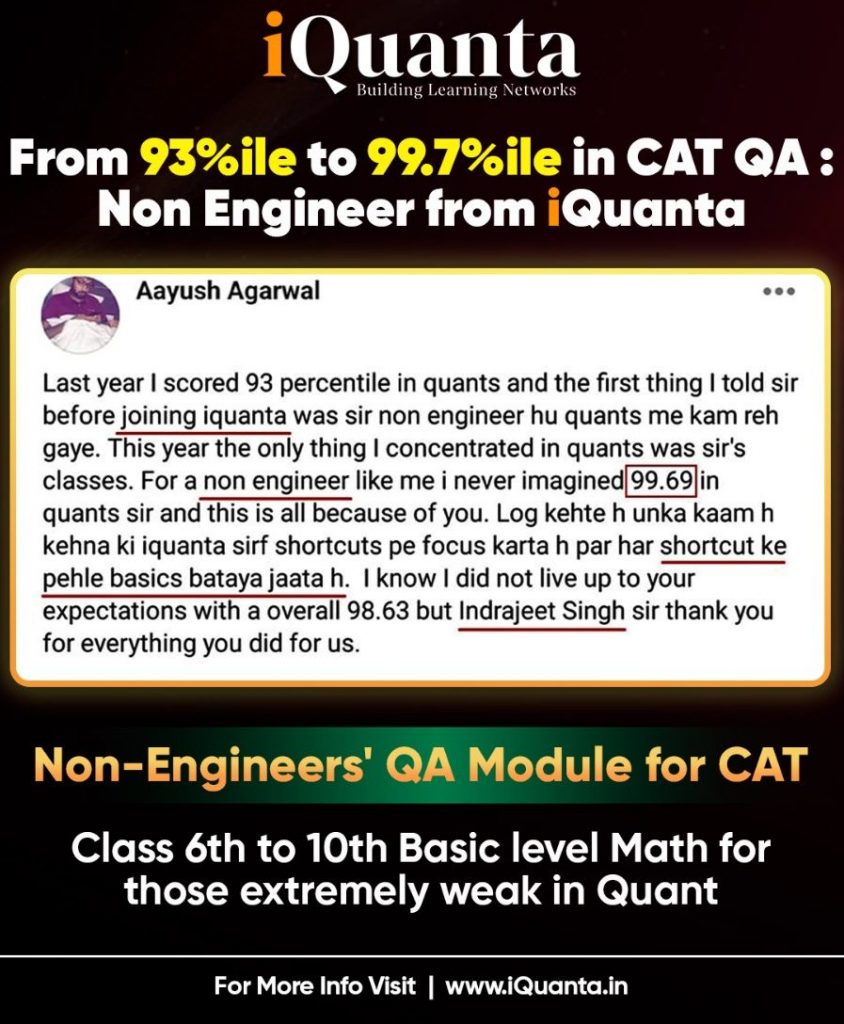The first and foremost thing about the difficulty in CAT exam is that is relative and vary from section to section and of course from person to person. While few might Verbal Ability and Reading Comprehension (VARC) extremely easy due to their reading habits, others might find Quantitative Ability (QA) very easy because they are associated with maths easily. It is very subjective and vastly depends on your strengths and weaknesses. So the toughest section in CAT depends on the aspirant’s strength and weaknesses. Try to maximize your strengths and focus on weak areas to make yourself more versatile and adaptive. Read this article to decode “Which is the toughest section in CAT” and other nuances associated with each of the sections.
Why VARC might be a challenge for you?
Complexity of Reading Comprehension Passages
The reading comprehension (RC) part is mostly filled huge and dense passages on a varied pool of topics such as philosophy, economics, metaphysical, science, or literature. It can be the answer to Which is the most toughest section in CAT? If you are not familiar or comfortable with a particular topic, you might spend too much time understanding the passage. This will leave you with very less time for answers and skim through the remaining passages. Moreover, the tone, intent, and implied meanings are prone to our own interpretation which may or may not correct.
Time Management
VARC questions require careful reading, sometimes you might want to re-read it again to understand any latent meaning. However, due to the exam’s time constraints force you have to find a balance between speed and accuracy which is a significant challenge. Therefore, first step is to pick the right RC and skim it through quickly so that you are able to answer the questions quickly and correctly.

Para-Jumbles and Summary Questions
VARC’s verbal ability section usually tries to tests how well you can structure ideas logically and identify meanings with limited information available. Para Jumbles sometimes look very simple but often leads to confusion between 2 sets of choices. Sometimes what seems like the most obvious answer goes wrong later. Without strong reasoning and a systematic approach (that comes from a solid foundation), you may struggle to find the right sequence or focus on the central theme with less information.
Ambiguity in Answer Choices
Many VARC questions have answer options that are very close to each other in meaning. Selecting the correct answer often requires smart judgment, however it may even the most prepared candidates. Hence, it is advised to leave a question or two if you are unable to figure anything out of it.
No defined syllabus
Though VARC improves by reading and maintaining a habit, we cannot discount the fact that it is the only section which has no particular syllabus that you can ever complete. It is just on the basis of practice and revisiting past year papers to understand what is being tested and prepare yourself accordingly.
Generally, engineers find the VARC section difficult than other sections. iQuanta has launched a special module for those who struggle in English and Grammar and find this section difficult. It has 40 videos on RC, 12 CAT VA videos with 10 VA questions, 7 strategy based videos and not only this and not only this you also get access to 60+ videos with 30 hours of VARC niche content only for CAT.

Why DILR might be a challenge for you?
Unpredictable Question Types
Very different from VARC and QA, where the types of questions usually follow a particular pattern, DILR is known for its tricky variations leading to a possible answer of Which is the most toughest section in CAT. A set might require interpreting a combination of charts, solving heaving numericals or analyzing a logical caselet or puzzle. This element of unpredictability makes preparation a bit difficult as you cannot rely solely on a particular type of question.
Complex Data Representation
Data interpretation questions often involve bar graphs, pie charts or tabular data (tables) with many variables. Finding the exact relevant information and calculating answers correctly with precision can be a time consuming task. Sometimes the images are not very clear as well which leads to some more confusion.
Time-Consuming Nature of Logical Reasoning
Logical reasoning problems like seating arrangements or other similar puzzles require you to process multiple conditions and parameters simultaneously. If you by chance solve one part of the problem incorrectly, it can potentially lead to a chain reaction of wrong answers for the entire set leading to negatives.
High Pressure to Maximize Scores
DILR is often coined as the “make-or-break” section because scoring well here can significantly boost your overall percentile or similar leave you in despair otherwise. This creates additional stress impacting your overall performance. Besides if you cannot crack a set, you tend to lose all 5 questions associated with it, leaving you with lesser further choices.
At iQuanta 50 LRDI sets have already been launched in the CAT LRDI inception module and more quality CAT level LRDI sets will be added. Other coaching institutes do not have any such module for the LRDI section.

Why QA might be a challenge for you?
Diverse Range of Topics
QA holds a vast syllabus, including arithmetic, algebra, geometry, number systems and modern mathematics. Mastering all of these topics is really difficult and hence can be an debated for Which is the toughest section in CAT. It requires both conceptual clarity and significant practice over time. Aspirants often find themselves stronger in certain areas but weak in others or overlook them totally, leading to inconsistent and fluctuating performance.
Conceptual Depth
Questions in QA are rarely straightforward. Even easy topics like percentages or ratios can be put up in a way that requires multi-step calculation and solving. Without a strong hold of concepts, you might find yourself stuck on questions that appear simple but have hidden complexities which eventually lead you to negatives.
Time Management During Calculations
While on-screen calculators are provided during the exam, many QA questions require mental calculations for intermediate steps. Using the calculator for smaller calculation eats up your time and leave you with lesser time for other questions. Balancing accuracy with speed becomes a big challenge, especially for people who struggle with numerical ability.
Fear of Mathematics
For many of us, math has been one of the subjects which we have feared since our school days. This psychological barrier can create anxiety at times which might affect performance even in simpler questions.
Non-Engineer’s Quants Module

iQuanta has launched a non engineer’s module that is designed for students who find maths extremely difficult and have not studied Maths after class 10. The topics are aligned with NCERT class 6-10 syllabus that clears all core concepts and you get all the required guidance starting from the basic level questions to advanced level questions. No other coaching institute has such a customized module.
Join the Largest CAT Preparation Community in India

What is the toughest section for you?
Post understanding the challenges mentioned above for each section, you should now know your strengths and weaknesses. And also probably Which is the toughest section in CAT? Give a thorough analysis of the same. Use a mock test or a past year CAT paper to understand where you stand. Clear the mind that any section is the toughest and it is a task to crack it. This mental barrier can bring down your confidence. It is just the matter of time and practice and you should be good to go in all the 3 sections of CAT. The next sections of the article will give you tips and tricks which you can incorporate too boost your preparation strategies leading to better results.
How to improve VARC?
- Develop Reading Habits: Try to build habit of reading newspapers, magazines and books from different genres such as economics, science, philosophy, and literature. This broadens your interpretation skills and improves familiarity with CAT-like RC topics. Having a focus on editorials and opinion writeups is useful for analytical reading.
- Practice Regularly: Solve at least 2 RC passages and around 10 – 15 VA questions daily. Use previous year’s CAT papers and sectional mocks to practice different question types such as para-jumbles, summaries, and odd-one-out. Analyse them well and try to find out any common mistake which you are repeatedly doing.
- Enhance Vocabulary and Grammar: Though CAT never asks for vocabulary directly but at times it is seen that students suffer in RCs and VA questions. Words which are not very commonly found in passages pose an issue in interpretation of the entire RC. Hence, the more you read, the better you are to get at it.
How to improve DILR?
- Practice Diverse Sets: Solve puzzles and sets from a variety of sources including but not limited to CAT previous year papers, mocks and other available study materials. Focus on data interpretation visuals like bar graphs, line graphs, pie charts and also on LR puzzles like seating arrangements, Venn diagrams and tournaments to name a few.
- Learn to Select Sets Wisely: Improve your ability to evaluate & assess set’s difficulty in a very quick span of time. Try to spend the first few minutes of every mock you take or practice session analyzing all the sets at once and then choose the set which is less complex or more familiar. Consistent practice will sharpen this judgment.
- Work on Speed and Accuracy: Always use time-bound practice sessions to develop the habit of solving sets within a time span of 8–10 minutes. There might be mock which are tougher and you can solve only 1 – 2 sets, similarly you can end up solving 3 sets some papers. Do not fret and get stuck with these things. Learn to keep going.
What to do to improve QA?
- Strengthen Basics: Master foundational concepts in arithmetic, algebra, geometry and number systems. Quants is the only section that has a proper syllabus attached to it. Do not leave any stones unturned in finishing the syllabus. Keep maintaining a formula book so that you can revisit them occasionally and you are never out of touch.
- Solve Topic-Wise Questions: Focus on one topic at a time and solve a large variety of problems from that particular topic. Start with arithmetic which includes ratios, percentages, time, speed and distance and move on to doing algebra followed by geometry. These 3 topics usually carries more than 85% of the total weightage in the section. Keep practising these to get better with time.
Enroll for iQuanta CAT 2025 Course


